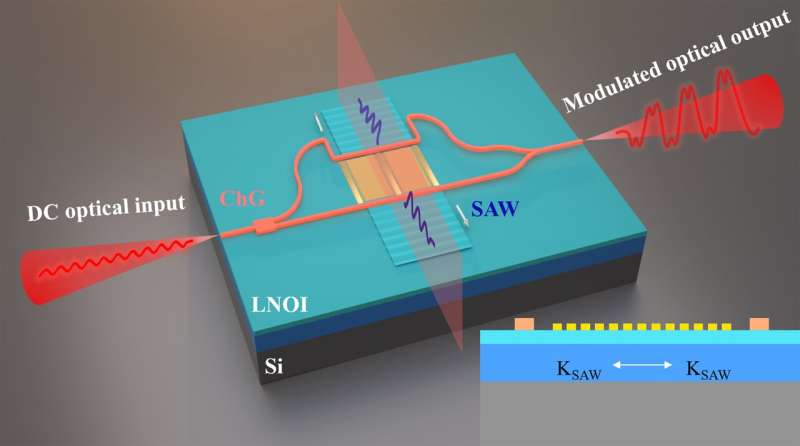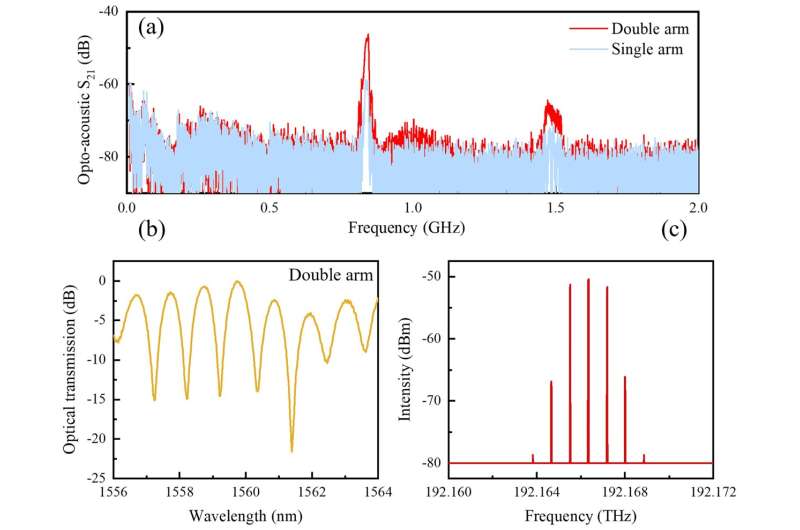Highly efficient acousto-optic modulation using non-suspended thin-film lithium niobate-chalcogenide hybrid waveguides

Traditional acousto-optic (AO) devices based on bulk crystal materials have weak energy confinement abilities for both photons and phonons, leading to a low AO interaction strength. Compared with bulk materials, photonic integrated circuits (PICs) allow surface acoustic waves (SAWs) to be well confined within the thin film used to disturb the guided light waves, exhibiting a high energy overlap within the wavelength scale.
In particular, as one of the most promising AO interaction platforms, thin-film lithium niobate (TFLN) provides great potential for the realization of high-performance AO modulators due to its superior advantages in piezoelectric transduction and electro-optical conversion. However, limited by the low optomechanical coupling coefficients, weak AO modulation efficiencies have become one of the bottlenecks for microwave-to-optical conversion in 5G/6G and emerging quantum signal processing applications.
In a new paper published in Light Science & Application, a team of scientists, led by Professor Zhaohui Li from Guangdong Provincial Key Laboratory of Optoelectronic Information Processing Chips and Systems, Sun Yat-sen University, China, Southern Marine Science and Engineering Guangdong Laboratory (Zhuhai), China, and co-workers Dr. Lei Wan, Dr. Zhiqiang Yang et al, has proposed and demonstrated a built-in push-pull acousto-optic modulator with a half-wave-voltage-length product VpL as low as 0.03 V cm, based on a non-suspended TFLN-chalcogenide glass (ChG) hybrid Mach–Zehnder interferometer waveguide platform.
The non-trivial acousto-optic modulator presents a modulation efficiency comparable to that of a state-of-the-art suspended counterpart. Compared to the traditional push-pull AO modulators, the proposed device prototype overcomes the issue of low modulation efficiency induced by the incoordinate energy attenuation of acoustic waves applied to the Mach–Zehnder interferometer with two arms. Combined with the simple fabrication processes and high-performance modulation efficiency, the built-in push-pull AO modulator is expected to show excellent characteristics in on-chip microwave-to-optical conversion devices.
The valuable AO modulation performance benefits from the superior photoelastic property of the chalcogenide membrane and the completely bidirectional participation of the antisymmetric Rayleigh surface acoustic wave mode excited by the impedance-matched interdigital transducer. Herein, the photoelastic coefficients of amorphous Ge25Sb10S65 film are estimated to be p11 " p12 " 0.238. Although the XZ direction may not be the most suitable crystal orientation due to the anisotropic feature of TFLN, reasonably engineering the impedance matching of IDT enables the realization of a 96% conversion efficiency in the microwave-to-acoustic conversion.

To demonstrate the low power consumption of the device, we construct an on-off modulation link using our non-suspended built-in push-pull AO modulator. The on-off modulated RF signal is loaded onto the DC optical carrier through the push-pull AO modulator, clearly demonstrating the microwave signal transmission capability of the developed on-chip AO modulator.
"The development of a highly efficient on-chip AO modulator as a key component will offer opportunities for emerging RF-driven on-chip optical isolators and integrated analog optical computing devices," the scientists forecast.
More information: Lei Wan et al, Highly efficient acousto-optic modulation using nonsuspended thin-film lithium niobate-chalcogenide hybrid waveguides, Light: Science & Applications (2022). DOI: 10.1038/s41377-022-00840-6
Journal information: Light: Science & Applications
Provided by Chinese Academy of Sciences





















